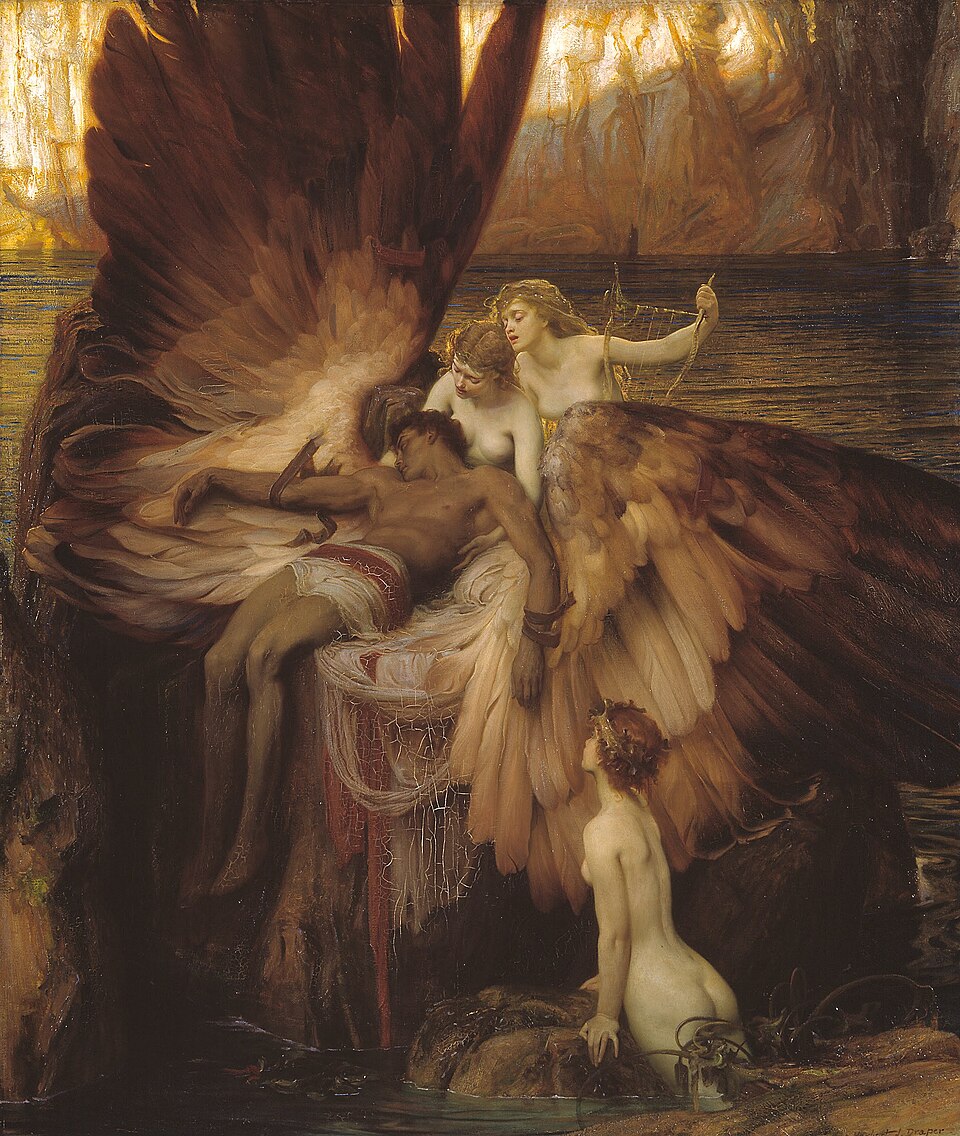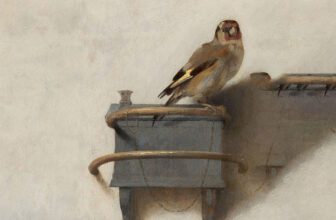
The Lament for Icarus: A Tale of Ambition and Tragic Fall
In the rich tapestry of mythological art, few images capture the poignancy of human ambition quite like The Lament for Icarus. At once breathtakingly beautiful and deeply mournful, this iconic painting portrays not just the fate of a single mythological figure, but the eternal struggle between aspiration and limitation. Floating in a dreamlike atmosphere, the painting immerses the viewer in the final act of one of mythology’s most tragic stories , the fall of Icarus.
The Artist Behind the Masterpiece
The Lament for Icarus was painted by Herbert James Draper, an English artist of the Victorian era. Born in London in 1863, Draper became one of the prominent figures of late 19th-century and early 20th-century art, renowned for his mythological and allegorical subjects. A master of the academic style, Draper had a flair for combining classical themes with a romantic touch , a synthesis perfectly captured in this painting.
Painted in 1898, The Lament for Icarus would go on to become Draper’s most celebrated work. It won the gold medal at the Paris Exposition Universelle in 1900 and brought Draper international acclaim. The painting remains a hallmark of his career and a cornerstone of mythological art.
The Meaning Behind the Painting
To understand the meaning of The Lament for Icarus, we must first revisit the myth it is based upon.
In Greek mythology, Icarus is the son of the master craftsman Daedalus, who designed the Labyrinth for King Minos of Crete. When Daedalus and Icarus sought to escape Crete, Daedalus fashioned two pairs of wings out of feathers and wax. He warned his son not to fly too high, lest the sun melt the wax, or too low, lest the sea dampen the wings.
But like many cautionary tales, youthful ambition triumphed over wisdom. Enthralled by the exhilaration of flight, Icarus soared too close to the sun. The wax in his wings melted, and he plummeted into the sea, where he drowned , leaving his father to grieve the price of pride and disobedience.
Draper’s painting captures the aftermath of this mythological tragedy. Unlike other depictions that focus on the fall itself, Draper gives us the lament , the sorrowful mourning that follows Icarus’s demise. The viewer is not witness to the dazzling flight or the sudden fall, but to the quiet, melancholic stillness of death.
This shift in focus transforms the painting into more than a mythological scene; it becomes a meditation on loss, ambition, and the fragile boundary between glory and ruin.
What Is Happening in the Painting?
In The Lament for Icarus, Draper presents the lifeless body of Icarus lying on a rocky shore, bathed in a soft golden light. His wings are tattered, their brilliant feathers scattered around him like petals. His skin glows with a soft, ethereal light, his expression serene , as if he is merely asleep. Surrounding him are grieving nymphs, water spirits who have discovered his body and mourn his fate.
This is not a scene of horror or violence. Instead, Draper suffuses the painting with romantic melancholy. The nymphs cradle Icarus with tender hands, their faces solemn. One looks directly at the viewer, drawing us into the mourning. The painting conveys a sense of timeless sorrow, a moment frozen between earth and myth.
The warm, golden hues of sunset add another layer of symbolism , the dying day echoing Icarus’s fall, light fading into twilight. Draper’s masterful handling of light and composition turns the scene into an emotional crescendo: we do not just see the tragedy; we feel it.
Symbolism and Themes
The Lament for Icarus is rich in allegorical meaning and visual symbolism:
The Wings: Once the symbol of freedom and daring, the broken wings now represent the price of ambition. Their fragility underscores the limits of human aspiration.
The Nymphs: These figures act as mourners and perhaps metaphors for nature’s indifference. Though they grieve, they are not responsible , they merely witness. Their presence elevates the myth to a universal truth: nature observes, man dares, fate judges.
Light and Shadow: Draper uses the interplay of light to highlight the contrast between life and death, ambition and consequence. Icarus is bathed in radiant golden light , suggesting perhaps the remnants of his glory , while the surrounding shadows remind us of his fate.
Water and Rock: The merging of soft water and hard stone evokes the clash between idealism and reality. The sea took Icarus, but it also gives him a kind of burial.
Ultimately, The Lament for Icarus invites us to reflect not just on a myth, but on the eternal human condition: the desire to transcend, the thrill of the impossible, and the inevitable reckoning.
Type and Style of Art
The Lament for Icarus is a prime example of Academic Art, particularly the Neoclassical and Pre-Raphaelite-inspired romanticism of the late Victorian period. Academic art was known for its technical precision, classical themes, and idealized figures , all of which are clearly present in Draper’s work.
Draper’s style bears hallmarks of:
Neoclassicism: The mythological subject, the idealized anatomy of Icarus, and the careful composition are rooted in classical traditions.
Romanticism: The emotional tone, the emphasis on individual suffering, and the dramatic use of color and light reflect romantic sensibilities.
Pre-Raphaelite Influence: Though not a member of the Pre-Raphaelite Brotherhood, Draper shared their attention to detail, vibrant palette, and fascination with myth and literature.
The painting’s technique is meticulous. Draper’s rendering of skin tones, fabric, and feathers is highly realistic, yet the scene itself remains otherworldly , suspended between dream and reality.
Where Is the Painting Today?
Today, The Lament for Icarus is housed in the Tate Britain gallery in London, where it remains one of the museum’s most treasured works. It is part of the Tate’s collection of late Victorian art and continues to draw admiration from art lovers, students, and myth enthusiasts alike.
The painting’s enduring presence in the Tate is a testament to its cultural impact. More than a century after it was painted, it continues to captivate viewers with its beauty and emotional depth.
Beyond the gallery walls, The Lament for Icarus has found a life in popular culture, literature, and modern reinterpretations. It has been reproduced in countless textbooks, art history collections, and exhibitions. Its haunting depiction of loss resonates with contemporary audiences, just as it did with those in Draper’s time.
Some literary critics and artists have even likened Icarus in this painting to modern figures of celebrity or genius , people who rise quickly and fall tragically, their brilliance extinguished too soon. Draper’s Icarus is no longer just a mythological boy; he is a symbol of anyone who dared to dream beyond the limits.
Comparisons with Other Depictions of Icarus
Draper’s portrayal of Icarus differs significantly from other famous works:
Bruegel the Elder’s “Landscape with the Fall of Icarus” (c. 1560): In this version, Icarus’s fall is barely noticeable, a pair of legs disappearing into the sea while peasants continue with their lives. The message is clear: life goes on, indifferent to personal tragedy.
Marc Chagall’s “The Fall of Icarus” (1975): This modernist take infuses the scene with surreal colors and abstract forms, emphasizing emotional turmoil and existential crisis.
Draper’s version, however, centers on beauty, pathos, and the emotional weight of Icarus’s fall. It invites compassion rather than commentary, making the viewer a participant in mourning.
Draper’s Vision: Humanity at the Edge
Herbert Draper was not merely retelling a myth; he was creating an image of the human spirit. Icarus becomes a romantic hero, not just a reckless boy. Draper’s Icarus is young, radiant, tragic , a figure we might all become when we reach too high.
Perhaps that is why the painting continues to haunt us. In Icarus, we see ourselves , full of dreams, buoyed by hope, vulnerable to hubris. Draper does not scorn Icarus; he honors him. The painting is not a cautionary tale so much as an elegy. It says: to strive is beautiful, even if one falls.
The Lament That Echoes Through Time
In The Lament for Icarus, Herbert James Draper gave the world more than just a stunning painting , he gave it a timeless reflection on the dual nature of ambition. Through sublime artistry, Draper captured the instant when aspiration and consequence meet, and in doing so, he transformed an ancient myth into a universal human moment.
It is a work of unparalleled emotion and technical brilliance, bridging the worlds of mythology, art, and philosophy. Today, as it hangs in Tate Britain, The Lament for Icarus invites each viewer to stand silently in mourning , not just for Icarus, but for the part of ourselves that dares to fly.




